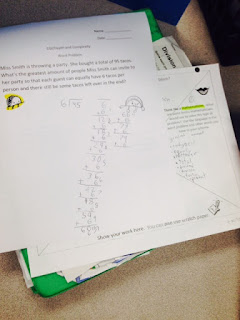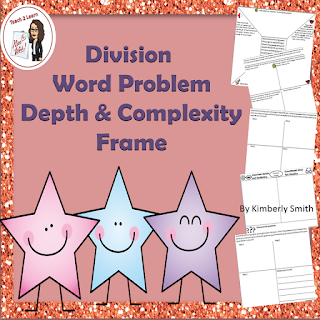I love to use Depth and Complexity frames in math especially with word problems! I still remember sitting on the floor at home when I was in elementary school and trying my best to figure out how to make sense of the math word problem I was given on my homework. Actually, I'm not quite sure I was really trying my "best." I probably read it a few times, stared at it, and called over my dad to help me out. That's not really persevering through problem solving like we teach our kids these days! Maybe if I had learned to carefully dissect the problem, I wouldn't have given up so easily. I'm not saying my teachers didn't teach me this; I had incredible teachers growing up, whom I owe a lot of my passion and creativity to. However, I don't really remember being shown a way to approach these problems (either that, or I wasn't paying attention).
When I was first introduced to the prompts of Depth and Complexity, I was a little bit overwhelmed but also excited and curious! Our school had just started to classify kids as GATE (Gifted and Talented Education), and we created one GATE class per grade level starting from 3rd grade all the way to 6th. During staff meetings and professional development, we slowly began to learn about some of the strategies for GATE, but being so overwhelmed with everything else going on in the classroom, I didn't experiment much with these areas.
Things quickly changed when I was asked to teach a 4th grade GATE class. I wasn't really sure how I felt about teaching a whole class of gifted kids, or in some instances, kids who were high achievers who still qualified to be part of the cluster. I've always enjoyed helping kids who were struggling in class, and I wasn't certain how I felt about teaching only kids on the opposite end (obviously, I had many misconceptions about GATE students). The more I thought about it, the more I realized it could be a wonderful and eye-opening experience and that I shouldn't be so close minded about change. Needless to say, I said "yes," and now had to move on to the interview process.
Depth and Complexity Frame
This process involved performing a lesson using GATE strategies! YIKES! I to use a frame to incorporate the prompts of Depth and Complexity. I chose to try the frame with math, and after lots of pondering, I created a word problem and frame. Now it was time to try it out with my general ed class. I included one of my student's names, hoping to keep him involved and intrigued. He actually loved it, and so did my other students!I found this activity challenged them, kept them busy, and they were also communicating and working as a team the whole entire time! Furthermore, breaking down the problem into four sections of the frame kept students involved in solving the word problem, and it allowed them to understand what was being asked much better.
Although I don't have a picture of the kids in action that day, I have some other photos of my actual GATE class solving a frame on division.
How to Use a Depth and Complexity Frame
Start at the Top with Details
I have the students start at the very top of the frame. In this section, they usually have to find the important details (flower icon) that are involved in the word problem. I write the word problem in the center of the frame, so everything is revolving around that story/math situation. Additionally, I try to create real world situations in which math would need to be used, and turn the problem into a short story. The details the students find are usually key pieces of information needed to solve the problem such as amounts, what they need to find out, and what is already known.
Details and All Write Round Robin
Because I really enjoy incorporating cooperative learning structures into my lessons, I have the students use an All Write Round Robin fashion during this first section of the frame, but it's optional. In my classroom, students are seated in table groups of six. Each student has a seat number ranging from 1-6, so I randomly choose a seat number to start the Round Robin process either by using the Smartboard die or spinner. Let's say the die lands on person 3. Person 3 would then need to find one detail in the word problem that they think is important when it comes to solving. He or she would then share this detail with the table group, and they would all write it down in the top portion of the frame. After person 3 shares, person 4 now finds another detail and the process continues. Students continue sharing until there aren't any other details to be found. If not every student gets to share, I ask them to add a detail that would be important to know or think about in order to solve.
Language of the Disciplines
Next, we move on to the right side of the frame which is usually the Language of the Discipline prompt. Here, I ask students to pair up with either their shoulder partner or face partner. They must now think of vocabulary terms and words a mathematician would use to discuss this math problem. Not only must they look for key words and clue words in the problem, but they also must think about other words that might be involved when solving this sort of problem. For example, if students start to realize that this is a division problem, they might use the word "dividend" or "quotient." They might also use phrases like "how many more" or "amount leftover."
Rally Robin
I ask partners to participate in a Rally Robin for this part of the frame. During Rally Robin, the students respond to each other in a ping-pong fashion. For example, partner A might say "remainder"and both students would write this down. Then, B might say "each", and again, both students write down this word. Back to partner A, "total," and then partner B "equally." This continues either until the timer goes off (if I use a timer) or until I tell the kids to stop. They really enjoy Rally Robin because it's like a game to them (and I ALWAYS make sure to call it a game because then they're very motivated to do well). ;)
Solve the Word Problem
After the second section of the frame is completed, we either move on to the left side of the frame, or I ask them to solve independently, depending on what the left side is commanding students to do. In this division frame, students are asked about left overs and what they should do if there's not enough for all of the guests. This could actually be answered before solving, but I prefer to have students answer this prompt after they've solved the problem. This way they can use their newly found answer to bring in some data.
I typically have students solve the problem independently because I want to see what they know on their own. Students solve in the bottom part of the frame, and I also give them an additional page with the word problem rewritten at the top of the page in larger font and with much more room to work the problem. See the picture below.
I ask that students arrive at the answer in more than one way. Some can do this and some struggle. That's okay because you want them to be challenged and to think outside the box. This is especially helpful with attacking the Common Core Standards. As students are solving, I walk around the room to observe the different strategies students are using.
Sharing Multiple Math Strategies
When students finish, they give me a thumbs up, and I check to see whether or not they got the correct answer. I also look for students solving in different ways, so I can share these strategies with the class. When I find these strategies, I take the student's paper without saying a word. Sometimes I'll set a timer while they solve, and other times I'll give them the time they need. Once most students are done, I have about 3-6 papers. The kiddos start to catch on and want me to choose their papers too.
Now I call these "chosen" students to the board to show what they did in order to solve (only one strategy per student). Another way you could do this is to quickly have the student explain his or her strategy while you quickly notate it on the board. Calling students up does take some time, so sometimes I only choose a few, or I even show their work on the document camera for all to see. In the end, students are exposed to a variety of different math strategies and thought processes that we can refer back to when solving similar problems.
Go Back to the Ethics Section
Oops! I almost forgot about the last section of the frame (the far left Ethics black and white triangle). I've done this two different ways. I've had the students answer right after solving and before I even look at their answers, and I've also gone over the answers, and then had the students respond to the prompt. It's completely up to the teacher. Basically, the students are sharing their opinions on what to do with not having enough left overs for everyone, so it doesn't affect the answer to the word problem.
Use a Frame to Introduce an Area of Math
I even like to use these word problem frames BEFORE actually teaching a certain concept in math. It's neat to see what kids come up with on their own. What's also nice is that these frames can be used with ALL students! We had a coring schedule for two years where I taught math and science to my GATE class, and then taught the same subjects to my general ed class. They both loved it and really enjoyed the challenge.
Try it Out with Your Students
I offer many different math frames, but here's the one on division. It comes with several different alternative frames too, and some pages where you can change the numerical amounts in the problem either to differentiate for different students or to use again and again!
https://www.teacherspayteachers.com/Product/Division-Word-Problem-Depth-and-Complexity-Frame-1617284
This is also part of a bundle which also features fraction and decimal word problem frames:
 |














I love teaching depth and complexity. Great idea!
ReplyDelete